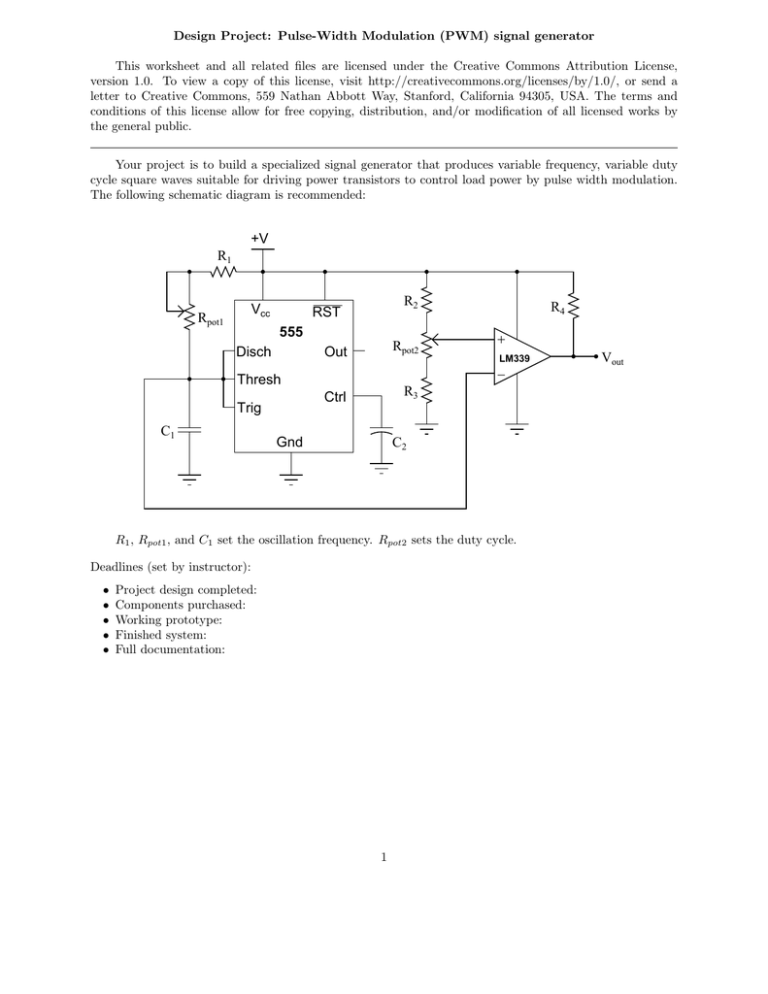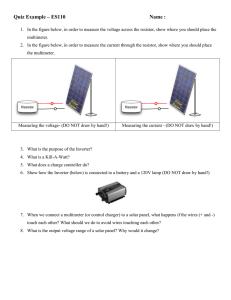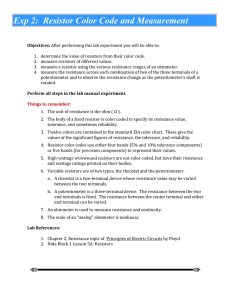Pulse-Width Modulation (PWM)
advertisement

Design Project: Pulse-Width Modulation (PWM) signal generator This worksheet and all related files are licensed under the Creative Commons Attribution License, version 1.0. To view a copy of this license, visit http://creativecommons.org/licenses/by/1.0/, or send a letter to Creative Commons, 559 Nathan Abbott Way, Stanford, California 94305, USA. The terms and conditions of this license allow for free copying, distribution, and/or modification of all licensed works by the general public. Your project is to build a specialized signal generator that produces variable frequency, variable duty cycle square waves suitable for driving power transistors to control load power by pulse width modulation. The following schematic diagram is recommended: +V R1 Vcc Rpot1 R2 RST + 555 Disch Out Rpot2 Ctrl R3 C1 LM339 − Thresh Trig R4 Gnd C2 R1 , Rpot1 , and C1 set the oscillation frequency. Rpot2 sets the duty cycle. Deadlines (set by instructor): • • • • • Project design completed: Components purchased: Working prototype: Finished system: Full documentation: 1 Vout Questions Question 1 What shape of voltage waveform would you expect to measure (using an oscilloscope) across capacitor C1 ? How does this waveform interact with the DC reference voltage at the wiper of Rpot2 to produce a pulse-width modulated square wave output? file 03195 Question 2 Which direction would you have to move the wiper on potentiometer Rpot2 to increase the duty cycle of the output waveform? Explain your answer. file 03194 Question 3 The design recommendation for this circuit is to make resistors R2 and R3 both equal to the resistance of the potentiometer Rpot2 . This way, the full mechanical range of the potentiometer will be useful for adjusting duty cycle: fully turning it one way will just produce a 0% duty cycle, while fully turning it the other way will just produce a 100% duty cycle. Explain why those resistor values need to be equal to achieve this optimum usage of pot range. Hint: it has something to do with the internal workings of the 555 timer IC. file 03193 Question 4 It is important to not make resistor R1 too small in value. Explain why, and what might happen if it were. file 03196 Question 5 For those of you who are used to working with regular opamps, the presence of resistor R4 may be a mystery. It is necessary because of a special limitation of the type LM339 comparator IC. Research and explain what this limitation is. file 03197 2 Question 6 The following modification may be made to the circuit to provide it with additional output current capability: +V +V R1 Rpot1 R5 Vcc RST R2 R4 + 555 Disch Out Rpot2 Ctrl R3 Thresh Trig C1 4049 Hex inverter R6 R7 Vout LM339 − R8 R9 Gnd C2 R10 Here, six CMOS inverters (IC part number 4049) are ganged together in parallel to supply significantly more sourcing and sinking current capability than the LM339-with-pullup-resistor could on its own. Since CMOS logic gates are inherently on-or-off devices, they have no trouble handling the square wave output of the LM339. Two questions here: first, why all the resistors at the outputs of the inverter gates? Why not just connect all the inverter outputs directly in parallel? Secondly, what value of resistor would you suggest at the output of each gate (R5 through R10 )? file 03198 3 Answers Answer 1 The waveform will be a ”sawtooth” shape. When compared against the DC reference voltage at Rpot2 ’s wiper by the LM339 comparator IC, the result is a square wave of varying duty cycle. Answer 2 Moving the wiper up (as drawn in the schematic) produces greater duty cycles. Answer 3 The sawtooth signal seen at capacitor C1 (with reference to ground) oscillates between voltage. 1 3 and 2 3 supply Answer 4 In the 555’s discharge cycle, resistor R1 will drop (almost) the full power supply voltage when Rpot1 is set for minimum resistance. Not only could this overheat R1 , but it could also damage the discharge transistor within the 555 timer. Answer 5 The LM339 comparator is only able to sink current at its output. Therefore, R4 acts as a pullup resistor. Follow-up question: is this (overall) circuit capable of sourcing current to a load? Explain why or why not. Answer 6 The resistors prevent the (unlikely) occurrence of a short-circuit between two or more inverter gates, if one gate happens to fail high or low, or if some gates are significantly slower than others (and thus will ”fight” with the faster gates during each transition). Challenge question: adding inverter gates to the output of this circuit has an interesting effect on the duty cycle control. The potentiometer will now act backward from the way it was before (decreasing duty cycle when it formerly increased duty cycle, and visa-versa). Explain why. 4 Notes Notes 1 Many students will initially be puzzled by the operating principle of this circuit. The best way I have found to answer their questions, I have found, is with a multi-trace oscilloscope (preferably one that can show three traces simultaneously). Connect one channel to the top of C1 , the next channel to Rpot2 ’s wiper, and the third to the comparator’s output terminal. A picture, as they say, is worth a thousand words. Notes 2 Notice that I did not even hint at why this is. Ask your students to fully explain their answers! Notes 3 This question forces students to explore what the 555 is really doing, and to recognize the comparator’s function in generating PWM square waves. Notes 4 In order to really understand why insufficient resistance at R1 would be a bad thing, students must understand the astable operating cycle of the 555 timer. This question provides a very practical context in which to explore and/or review it! Notes 5 This characteristic of the LM339 caused problems for me the first few times I tried to use it in my designs. Despite this limitation, though, the LM339 is very aptly suited for this application with its fast response and very wide power supply voltage limits. Notes 6 This question may or may not be suitable for your students, depending on whether or not they have studied logic gates yet. If they have not yet studied digital circuits, it may be wise to skip this question! Note that I did not answer the question of resistor sizes. Discuss this with your students, and let them determine how these resistors should be sized. Let them have access to datasheets for the 4049 inverter IC, and ask them what parameter(s) would be the most important in this decision. If no one notices, point out how the power supply wires are drawn for the six-gate (hex) inverter. This is a common way to show power wiring for multiple gates (or opamps, or any other sort of IC where complex elements are duplicated). 5





